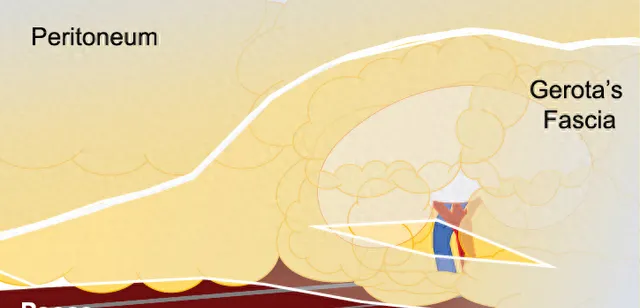肾测量评分量化手术复杂性,但受限于观察者和时间。AI能缓解此障碍,与人类专家一样预测肿瘤结果,对临床有价值。
虽然RENAL评分将连续的变量进行分类,简化了评分过程,但这一过程中也丢失了有价值的信息。就像肾脏质量直径为4-7厘米被简单归为2分,但6.9cm和4.1cm的内生性肾质量预后却大不相同。RENAL评分对每个组成部分一视同仁,简单相加。而AI评分则不受这些限制,通过复杂的多变量模型,将连续的评分组件完美结合。我们利用AI生成的分段和多元逻辑回归的连续变量,创造了全新的AI+评分!

图 1. 接受者操作特征曲线评估不同 RENAL 评分的病理结果的预测能力(半径、内生/外生、与集合系统的距离、前/后、相对于极线的位置)评分:人工智能 (AI)–生成的连续分数(红色)、AI 生成的分类分数(绿色)和人类生成的分数(蓝色)。FPF表示假阳性分数;TPV,真阳性值。

图 2. 评估手术类型对不同肾(半径、内生/外生、距集合系统的距离、前/后、相对于极线的位置)评分的预测能力的受试者操作特征曲线:人工智能 (AI)–生成的连续分数(红色)、AI 生成的分类分数(绿色)和人类生成的分数(蓝色)。
"回顾2010-2018年300名疑似肾癌患者,排除血栓患者,用最大肿瘤生成肾测量评分。数据公开于https://kits21.kits-challenge.org/。使用深度神经网络自动生成肾实质和肿瘤的分割掩模,几何算法将分数估计为序数和连续变量。每个肿瘤都有AI生成的RENAL评分(AI+评分)、有序RENAL评分(AI-score)和传统RENAL评分(H-score)。AI+评分是自动生成的连续分量的组合,无需相加。使用多元逻辑回归研究其预测能力,比较AI+、AI评分。"
该队列中,患者中位年龄60岁,40%为女性。肿瘤中位大小4.2cm,92%为恶性。AI+评分在预测恶性肿瘤、高阶段、高级别、坏死和部分肾切除方面表现良好。最大肿瘤直径是AI+评分最重要的预测因子。高度疾病和肿瘤坏死与AI+评分相关。研究存在局限性,包括2%的失败率和来自70个医疗机构的CT图像,但我们认为这是可以接受的,并认为这为研究的普遍性和外部有效性奠定了基础。
"AI+ 评分基于连续变量,无人为干预,能更准确预测肿瘤结果。自动分割和肾测量评分减少了解释差异,提高数据质量。在新治疗时代,准确预测不良病理和肿瘤结果的需求迫切。我们的数据支持临床医生信赖全自动版本,并可作为开发更先进系统的重要步骤。"
Joshi SS, Uzzo RG. Renal tumor anatomic complexity: clinical implications for urologists. Urol Clin North Am . 2017;44(2):179-187.
Kutikov A, Uzzo RG. The R.E.N.A.L. nephrometry score: a comprehensive standardized system for quantitating renal tumor size, location and depth. J Urol . 2009;182(3):844-853.
Kutikov A, Smaldone MC, Egleston BL, et al. Anatomic features of enhancing renal masses predict malignant and high-grade pathology: a preoperative nomogram using the RENAL nephrometry score. Eur Urol . 2011;60(2):241-248.
Weight CJ, Atwell TD, Fazzio RT, et al. A multidisciplinary evaluation of inter-reviewer agreement of the nephrometry score and the prediction of long-term outcomes. J Urol . 2011;186(4):1223-1228.
Chapin BF, Wood CG. The RENAL nephrometry nomogram: statistically significant, but is it clinically relevant?. Eur Urol . 2011;60(2):249-251.
Spaliviero M, Poon BY, Aras O, et al. Interobserver variability of R.E.N.A.L., PADUA, and centrality index nephrometry score systems. World J Urol . 2015;33(6):853-858.
Heller N, Tejpaul R, Isensee F, et al. Computer-generated R.E.N.A.L. nephrometry scores yield comparable predictive results to those of human-expert scores in predicting oncologic and perioperative outcomes. J Urol . 2022;207(5):1105-1115.
Altman DG, Royston P. The cost of dichotomising continuous variables. BMJ . 2006;332(7549):1080.
Heller N, Isensee F, Maier-Hein KH, et al. The state of the art in kidney and kidney tumor segmentation in contrast-enhanced CT imaging: results of the KiTS19 challenge. Med Image Anal . 2021;67:101821.











